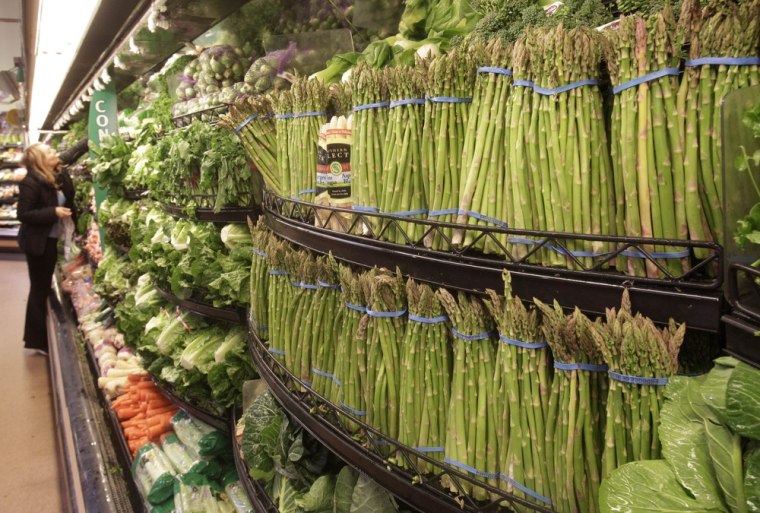A nearly 50 percent increase in vegetable prices that has sent shoppers reeling in the produce aisle should ease in the coming weeks as farmers send grocers more tomatoes, lettuce and other crops.
Vegetable prices shot up last month after cold weather in the southern U.S. and Mexico destroyed much of the winter vegetable supply, the Commerce Department said. From tomatoes in Florida to lettuce in Arizona, fruit and vegetables became frostbitten, and prices rose for the produce farmers could save.
Costs should be coming down soon, though, as crops farmers planted after the winter freezes start to reach stores, said growers, grocers and analysts. Grocers also typically switch this time of year to crops planted for spring, said Jody Shee, an analyst for the market research firm Mintel.
"Unless there are any other weather issues, the prices should bounce back pretty soon," she said.
The Iowa-based Hy-Vee supermarket chain, which has more than 230 stores in the Midwest, already is seeing cheaper prices for lettuce, broccoli and other vegetables, spokeswoman Ruth Comer said. But tomatoes and cucumbers, which were hit hard by cold weather in Mexico, could remain high for one more month, she said.
Vegetables imported from Mexico often offset losses in the U.S. during winter freezes, but that wasn't the case this year because the cold stretched further south than usual, said Gary Lucier, an agricultural economist with the U.S. Department of Agriculture's Economic Research Service.
The result was the biggest one-month increase in overall food prices Americans have seen since 1974 and the steepest rise in U.S. inflation in nearly two years.
"I've been paying more on everything," said Anne Schwartz, 63, who lives west of Chicago in Winfield, Ill. "You used to be able to walk in there and get three avocados for a dollar."
Now, avocados cost $1 each at her local grocery, she said.
Although shoppers are paying more, farmers in the Sun Belt say they haven't been getting rich. Most lost at least some of their crops, and they said the higher prices have just been helping make up for it.
Bob Spencer, co-owner of West Coast Tomato in Palmetto, Fla., said two freezes in December left him with about 30 to 40 percent of the crop he usually gets on the 4,000 acres he planted this year. But with tomatoes selling for more than $30 for a 25-pound box in some cases, at least double what farmers usually get, according to the U.S. Department of Agriculture, the loss hasn't been devastating.
"As long as you had some product through this winter period, you're going to be able to come through and make money," Spencer said.
And, for many tomato farmers who "overplant" their crop, a freeze can prevent the price drops — and loss of profits — that a strong harvest can cause, he said.
That was a problem last year, when a bad freeze caused similar jumps in tomato prices, but then farmers flooded the market with a second crop and prices plummeted.
"We left a lot of money in the field last year," said Reggie Brown, executive vice president of the Florida Tomato Growers Exchange in Maitland, Fla. "The industry went into this year, to characterize it, with a limp."
In Yuma, Ariz., where much of the nation's winter lettuce is grown, Steve Alameda said two days of temperatures below 20 degrees froze his Romaine and Iceberg plants.
"The lettuce actually blisters," Alameda said. "When you start to harvest, you have to cut all that out. Your yields were basically cut in half."
But greens grow relatively quickly, and Alameda said production of some lettuce and other crops grown in his region are already starting to pick up.
"We'll do better on account of (the circumstances) than we would have without it," Alameda said, referring to the jump in prices. "There'll be some who will, some who won't."
Prices for a handful of crops, like melons, that take longer to grow could take a longer to drop, said John McClung, president of the Texas Produce Association, a group of produce shippers and growers in the Rio Grande Valley in deep south Texas.
"It takes in some cases a season," he said. But farmers in his area, too, have had a decent winter financially with higher prices making up for losses caused by an unusual spell of cold weather.
"In agriculture," he said, "the rule is that there are always winners and losers every season."
